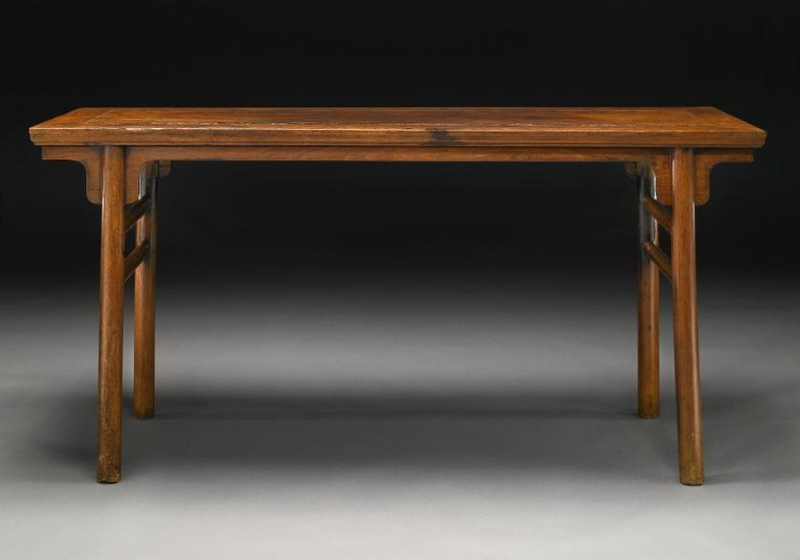Sotheby's. Fine Chinese Ceramics & Works of Art. New York, 19 march 2013
A huanghuali recessed-leg painting table (pingtouan), 17th-18th century
Lot 466. A huanghuali recessed-leg painting table (pingtouan), 17th-18th century; Height 32 in., 81.3 cm; Width 67 in., 170.18 cm; Depth: 23 in., 58.5 cm. Estimate: 120,000 — 180,000 USD. Lot sold 395,000 USD. © Sotheby's
of standard floating-panel top secured by a wide frame with molded and beaded edge with three transverse stretchers beneath, on paired recessed legs of circular section secured by parallel cross-braces of oval section, the simple straight aprons with rounded spandrels, the wood of a rich dark amber color.
Property from the Collection of Miriam and Ira D. Wallach.
Provenance: Nicholas Grindley Ltd., London, April 12, 1996
Note: The classic form of the present table has historically been referred to a 'character one' table type. The Chinese word for 'one' is written as a single horizontal stroke giving a graphic image of this type of very linear table.The descriptive term of 'character one table type' (yi zi zhou shi) is taken from the Wanli period edition of the Lu Ban jing jiang jia jing,(The Classic of Lu Ban and the Craftsman's Mirror), named after the mythical patron of the carpenter's craft and containing information on architectural woodwork and the making of furniture.
These tables were designed as surfaces on which to paint. The height and depth are appropriately proportioned for an artist to stand and freely use the brush over a long paper or silk surface. Often the surface of painting tables will be stained with ink or will bear burn marks, both indicative of the use they received. Occasionally, these tables will have regularly spaced score marks across the top. These scratches were used both as a ruler for measurement of the paper or silk surface or are scratches made by the knife blade as it cut the paper to the appropriate length. Fine-grain wood were reserved for painting tables as the craftsmen strove for the pure beauty of the grain and structural form.
Compare a huanghuali table of slightly larger proportions, sold in these rooms, 19th March 1997 lot 383 and again 23rd March 2011, lot 671 and another of similar size to the present example sold in our Hong Kong rooms 5th October 2011, lot 2107.

/https%3A%2F%2Fprofilepics.canalblog.com%2Fprofilepics%2F1%2F0%2F100183.jpg)
/https%3A%2F%2Fstorage.canalblog.com%2F03%2F02%2F119589%2F96711876_o.jpg)
/https%3A%2F%2Fstorage.canalblog.com%2F11%2F31%2F119589%2F94773502_o.jpg)
/https%3A%2F%2Fstorage.canalblog.com%2F20%2F83%2F119589%2F94772815_o.jpg)
/https%3A%2F%2Fstorage.canalblog.com%2F26%2F72%2F119589%2F75604929_o.jpg)
/https%3A%2F%2Fstorage.canalblog.com%2F59%2F60%2F119589%2F26458628_o.jpg)





/image%2F1371349%2F20240409%2Fob_fc01a6_2024-nyr-22642-0899-000-a-rare-small-h.jpg)
/image%2F1371349%2F20240409%2Fob_1299ed_2024-nyr-22642-0898-000-a-rare-huanghu.jpg)
/image%2F1371349%2F20240403%2Fob_b08891_telechargement-4.jpg)
/image%2F1371349%2F20240403%2Fob_b24488_telechargement.jpg)